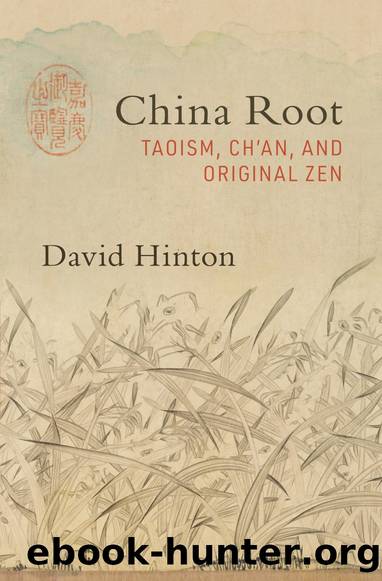China Root: Taoism, Châan, and Original Zen by David Hinton

Author:David Hinton [Hinton, David]
Language: eng
Format: epub
ISBN: 9781611807134
Google: ZVj6DwAAQBAJ
Barnesnoble:
Publisher: Shambhala
Published: 2020-09-29T00:00:00+00:00
Hsieh Ling-yün began a Châan sense of landscape practice in the amalgam of his poetry and the understanding revealed in his Châan essay. Then, as Châan developed in the centuries that followed, its empty mirror-mind transformed Chinese poetry, grounding it in the clarity of rivers-and-mountains images. This imagistic clarity became the fabric from which poetry was made, poetry that was widely considered a form of Châan practice and teaching. And in a culture where there is no distinction between heart and mind, it makes sense. Perception clarified by meditation until it is empty-mind mirroring the ten thousand things, mirroring rivers-and-mountains landscape: it isnât just an intellectual or spiritual experience, it is also an emotional experience, an experience of the heart. That experience of the heart is presumably the purview of poetry, and indeed there is no end of such rivers-and-mountains poems in ancient China. A quintessential example is work by the great Wang Wei (701â761), a seminal figure in rivers-and-mountains poetry and painting (and whom we will see writing an influential memorial inscription for the Sixth Patriarch):
Magnolia Park
Autumn mountains gathering last light,
one bird follows another in flight away.
Shifting kingfisher-greens flash radiant
scatters. Evening mists: nowhere they are.
Or this especially pure imagistic poem by Tu Mu, who we saw (this page) dismantling the mirror metaphor:
Egrets
Robes of snow, crests of snow, and beaks of azure jade,
they fish in shadowy streams. Then startling up into
flight, they leave emerald mountains for lit distances.
Pear blossoms, a tree-full, tumble in the evening wind.
A rivers-and-mountains poetry of images weaves the identity-center into landscape as accurately as language can. It thereby renders a larger identity, an identity that is made of landscape. This is the heart of Châan as landscape-practice: in mirror-deep perception, earthâs vast rivers-and-mountains landscape replaces thought and even identity itself with its breath-emergent blaze, revealing the unity of consciousness and landscape/Cosmos that was sage dwelling for Châan practitioners, and indeed for all artist-intellectuals in ancient China. It returns us to our most primal nature, that inner wilds where we are indeed the awakened landscape gazing out at itself.
In the end, Châan revered rivers-and-mountains landscape (much like empty-mind) as a great teacher. This is implicit as an assumption throughout the tradition, and we find it stated openly when Wang Wei mourns the death of his great predecessor in the lineage of imagistic Châan landscape poetry:
Mourning Meng Hao-jan
My dear friend nowhere in sight,
this Han River keeps flowing east.
Now, if I look for old masters here,
I find empty rivers-and-mountains.
And Visitation-Land states it directly:
A monk asked Master Visitation-Land: âWhat is my teacher?â
Visitation-Land replied: âClouds rising out of mountains, streams entering valleys without a sound.â
Download
This site does not store any files on its server. We only index and link to content provided by other sites. Please contact the content providers to delete copyright contents if any and email us, we'll remove relevant links or contents immediately.
| Philosophy | Spirituality |
The Way of Zen by Alan W. Watts(6460)
Ego Is the Enemy by Ryan Holiday(5241)
The Art of Happiness by The Dalai Lama(4015)
The Book of Joy by Dalai Lama(3863)
Why Buddhism is True by Robert Wright(3378)
Spark Joy by Marie Kondo(3196)
Shift into Freedom by Loch Kelly(3103)
Happiness by Matthieu Ricard(2967)
A Monk's Guide to a Clean House and Mind by Shoukei Matsumoto(2847)
The Lost Art of Good Conversation by Sakyong Mipham(2510)
The Meaning of the Library by unknow(2476)
The Unfettered Mind: Writings from a Zen Master to a Master Swordsman by Takuan Soho(2208)
The Third Eye by T. Lobsang Rampa(2207)
Anthology by T J(2129)
Red Shambhala by Andrei Znamenski(2123)
The Diamond Cutter by Geshe Michael Roach(1999)
Thoughts Without A Thinker: Psychotherapy from a Buddhist Perspective by Epstein Mark(1944)
Twilight of Idols and Anti-Christ by Friedrich Nietzsche(1811)
Advice Not Given by Mark Epstein(1800)
